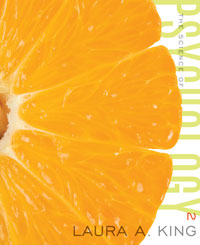| motivation | The force that moves people to behave, think, and feel the way they do.
|
 |
 |
 |
| instinct | An innate (unlearned) biological pattern of behavior that is assumed to be universal throughout a species.
|
 |
 |
 |
| drive | An aroused state that occurs because of a physiological need.
|
 |
 |
 |
| need | A deprivation that energizes the drive to eliminate or reduce the deprivation.
|
 |
 |
 |
| homeostasis | The body's tendency to maintain an equilibrium, or steady state.
|
 |
 |
 |
| Yerkes-Dodson law | The psychological principle stating that performance is best under conditions of moderate arousal rather than either low or high arousal.
|
 |
 |
 |
| set point | The weight maintained when the individual makes no effort to gain or lose weight.
|
 |
 |
 |
| anorexia nervosa | Eating disorder that involves the relentless pursuit of thinness through starvation.
|
 |
 |
 |
| bulimia nervosa | Eating disorder in which an individual (typically female) consistently follows a binge-and-purge eating pattern.
|
 |
 |
 |
| binge eating disorder (BED) | Eating disorder characterized by recurrent episodes of consuming large amounts of food during which the person feels a lack of control over eating.
|
 |
 |
 |
| hierarchy of needs | Maslow's theory that human needs must be satisfied in the following sequence: physiological needs, safety, love and belongingness, esteem, and self-actualization.
|
 |
 |
 |
| self-actualization | The motivation to develop one's full potential as a human being—the highest and most elusive of Maslow's proposed needs.
|
 |
 |
 |
| self-determination theory | Deci and Ryan's theory asserting that all humans have three basic, innate organismic needs: competence, relatedness, and autonomy.
|
 |
 |
 |
| intrinsic motivation | Motivation based on internal factors such as organismic needs (competence, relatedness, and autonomy), as well as curiosity, challenge, and fun.
|
 |
 |
 |
| extrinsic motivation | Motivation that involves external incentives such as rewards and punishments.
|
 |
 |
 |
| self-regulation | The process by which an organism effortfully controls behavior in order to pursue important objectives.
|
 |
 |
 |
| emotion | Feeling, or affect, that can involve physiological arousal (such as a fast heartbeat), conscious experience (thinking about being in love with someone), and behavioral expression (a smile or grimace).
|
 |
 |
 |
| polygraph | A machine, commonly called a lie detector, that monitors changes in the body, used to try to determine whether someone is lying.
|
 |
 |
 |
| James-Lange theory | The theory that emotion results from physiological states triggered by stimuli in the environment.
|
 |
 |
 |
| Cannon-Bard theory | The proposition that emotion and physiological reactions occur simultaneously.
|
 |
 |
 |
| two-factor theory of emotion | Schachter and Singer's theory that emotion is determined by two factors: physiological arousal and cognitive labeling.
|
 |
 |
 |
| facial feedback hypothesis | The idea that facial expressions can influence emotions as well as reflect them.
|
 |
 |
 |
| display rules | Sociocultural standards that determine when, where, and how emotions should be expressed.
|
 |
 |
 |
| negative affect | Unpleasant emotions such as anger, guilt, and sadness.
|
 |
 |
 |
| positive affect | Pleasant emotions such as joy, happiness, and interest.
|
 |
 |
 |
| broaden-and-build model | Fredrickson's model of positive emotion, stating that the function of positive emotions lies in their effects on an individual's attention and ability to build resources.
|





